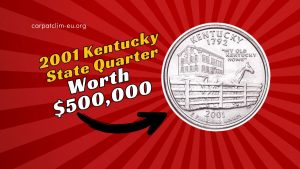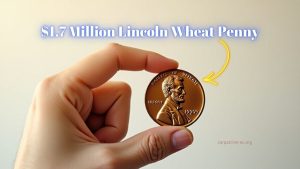Coin collecting isn’t just a hobby—it’s a journey into history and artistry. Among the treasures that captivate collectors, certain coins command astronomical prices due to their rarity, design errors, and historical significance.
Today, we spotlight the 1918-S Buffalo Nickel, which has recently been valued at around $125,000 in top condition, and explore five other rare finds that continue to mesmerize numismatists worldwide.
The Star of the Show: 1918-S Buffalo Nickel
Minted between 1913 and 1938, the Buffalo Nickel—also known as the Indian Head nickel—features a striking Native American portrait on the obverse and an impressive buffalo on the reverse. The 1918-S variety is particularly coveted.
With a mintage of nearly 4,882,000 pieces and only the finest examples (graded MS66 by professional grading services) reaching record prices, this coin exemplifies the delicate balance between mass production and the rarity of high-grade specimens.
Its exceptional detail, including sharp, well-preserved design features, makes it a must-have for collectors seeking quality and history in one small piece of metal.
5 More Rare Finds in the Numismatic World
Beyond the iconic 1918-S Buffalo Nickel, the numismatic world is home to several other coins that have set auction records and captured the imaginations of collectors:
1. 1913 Liberty Head Nickel
One of the most celebrated rarities in American coinage, the 1913 Liberty Head Nickel—often dubbed the “Mona Lisa of Rare Coins”—has only five known specimens.
With one example having fetched over $3.7 million at auction, its unauthorized production and minuscule mintage make it one of the most legendary finds in U.S. numismatics.
2. 1943 Bronze Lincoln Cent
An error coin with a fascinating backstory, the 1943 Bronze Lincoln Cent was accidentally minted in bronze instead of the standard zinc-coated steel during World War II.
This rarity, with its limited survival and distinctive composition, has been valued at around $336,000 and remains one of the most sought-after error coins in circulation.
3. 1933 Gold Double Eagle
Arguably the crown jewel of American coinage, the 1933 Gold Double Eagle is steeped in intrigue. With nearly 445,500 coins struck before an executive order halted their circulation—and most were ordered melted down—only 13 specimens are known to exist today.
One private specimen has even commanded prices upwards of $18.9 million, making it the most expensive U.S. coin ever sold.
4. 1652 NE Threepence
Diving into the pre-federal era, the 1652 NE Threepence is a remarkable coin from before the establishment of the U.S. Mint.
This coin, bearing the “NE” stamp (for New England) and a Roman numeral three, recently broke records by selling for $2.52 million. Its rarity and historical significance make it a prized possession among collectors of early American coinage.
5. Brasher Doubloon
Finally, the Brasher Doubloon stands as a testament to early American private minting. Struck by goldsmith Ephraim Brasher in 1787, this coin is a singular piece of numismatic history.
With one specimen having fetched a record $9.36 million at auction, the Brasher Doubloon is not only rare but also an icon of American innovation in coinage.
| Coin | Year | Notable Feature | Record Price (USD) |
|---|---|---|---|
| 1918-S Buffalo Nickel | 1918 | High-grade (MS66), exceptional detail | ~$125,000 |
| 1913 Liberty Head Nickel | 1913 | Only 5 known; unauthorized minting | >$3,700,000 |
| 1943 Bronze Lincoln Cent | 1943 | Error coin minted in bronze during WWII | ~$336,000 |
| 1933 Gold Double Eagle | 1933 | Almost all melted; only 13 survive; illegal for private ownership | ~$18,900,000 |
| 1652 NE Threepence | 1652 | Pre-federal era; “NE” stamp with Roman numeral three | ~$2,520,000 |
| Brasher Doubloon | 1787 | Private minting by Ephraim Brasher; historical rarity | ~$9,360,000 |
The world of coin collecting is a fascinating blend of art, history, and investment. The 1918-S Buffalo Nickel is just one example of how even everyday currency can become a coveted treasure in the right condition.
From the mystique of the 1913 Liberty Head Nickel to the monumental record of the 1933 Gold Double Eagle, these coins offer a tangible connection to our past.
Whether you’re a seasoned collector or just starting out, understanding the factors that drive a coin’s value—such as mintage, grading, and error features—can transform spare change into a priceless legacy.
Dig deep into your pocket change; you never know which rare coin might be waiting to change your life.
FAQs
What makes the 1918-S Buffalo Nickel so valuable?
Its value comes from its limited number of high-grade specimens, exceptional design detail, and historical significance during a pivotal era in American coinage.
How are coin grades determined?
Coins are graded on a scale from 1 to 70, with higher grades (typically MS65 and above) indicating minimal wear, exceptional luster, and sharp details, thereby increasing their market value.
Why are error coins, like the 1943 Bronze Lincoln Cent, so sought after?
Error coins are rare because production mistakes are unintentional and occur in very limited numbers, making them highly coveted by collectors for their uniqueness and historical story.




